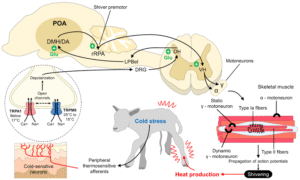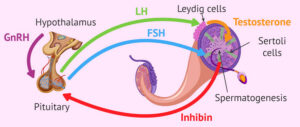Back to: ZOOLOGY 400 Level
Welcome to class!
Hello my brilliant friend! It’s always exciting to have you in class — your consistency and curiosity show you’re truly committed to understanding how life works. Today, we’re going to look at something very important in reproduction and male fertility: Spermatogenesis and Hormonal Regulation. These processes are like a well-organised factory inside the male body, producing millions of sperm cells daily — let’s break it down simply and clearly, like we always do.
Spermatogenesis And Hormonal Regulation
Spermatogenesis
Spermatogenesis is the process of sperm production in males. It happens in a part of the testis called the seminiferous tubules.

It begins with special cells called spermatogonia, which go through several stages to become mature sperm cells (spermatozoa). The stages are:
Spermatogonia divide by mitosis to produce primary spermatocytes.
Primary spermatocytes divide by meiosis to form secondary spermatocytes.
Secondary spermatocytes divide again to form spermatids.
Spermatids undergo maturation (spermiogenesis) to become fully functional spermatozoa.
This process takes about 64–72 days, and it happens continuously after puberty. Each sperm cell has a head (with DNA), a midpiece (with energy), and a tail (for movement).
Hormonal Regulation of Spermatogenesis
This entire process is carefully controlled by hormones from the brain and testes. Here’s how they work together:
The hypothalamus in the brain releases GnRH (Gonadotropin-releasing hormone).

GnRH signals the pituitary gland to release:
FSH (Follicle-Stimulating Hormone) – which acts on Sertoli cells in the testes to support sperm development.
LH (Luteinising Hormone) – which acts on Leydig cells to produce testosterone.
Testosterone is the main male hormone that promotes sperm production, male characteristics (like deep voice, beards), and sex drive.

There’s also a feedback system: if testosterone levels rise too high, the hypothalamus and pituitary reduce their hormone production to maintain balance.
Example: Think of the brain as the manager, the pituitary as the supervisor, and the testis as the factory. The manager sends signals, the supervisor gives instructions, and the factory produces sperm — all in perfect coordination.
Why This Is Important
Without proper hormonal control, spermatogenesis can slow down or stop. That’s why hormonal imbalances or issues like stress, illness, or drug abuse can affect fertility in men. Understanding this process helps us appreciate male reproductive health and the miracle of human life.
Summary
- Spermatogenesis is the process of sperm cell production in the seminiferous tubules.
- It starts from spermatogonia and ends with mature spermatozoa.
- The hypothalamus and pituitary control the process through GnRH, FSH, and LH.
- LH stimulates testosterone production; FSH supports sperm development.
- A feedback loop maintains hormonal balance for steady sperm production.
Evaluation
- What is spermatogenesis and where does it occur?
- Name the stages from spermatogonia to spermatozoa.
- What is the role of testosterone in spermatogenesis?
- How do FSH and LH contribute to sperm production?
- Explain the hormonal feedback system involved.
Well done, champ! You’re building a deep understanding of the human body — something many people only wish they knew. Keep growing, stay curious, and trust that with Afrilearn by your side, you’re on the path to success, excellence, and greatness. You’ve got this!
